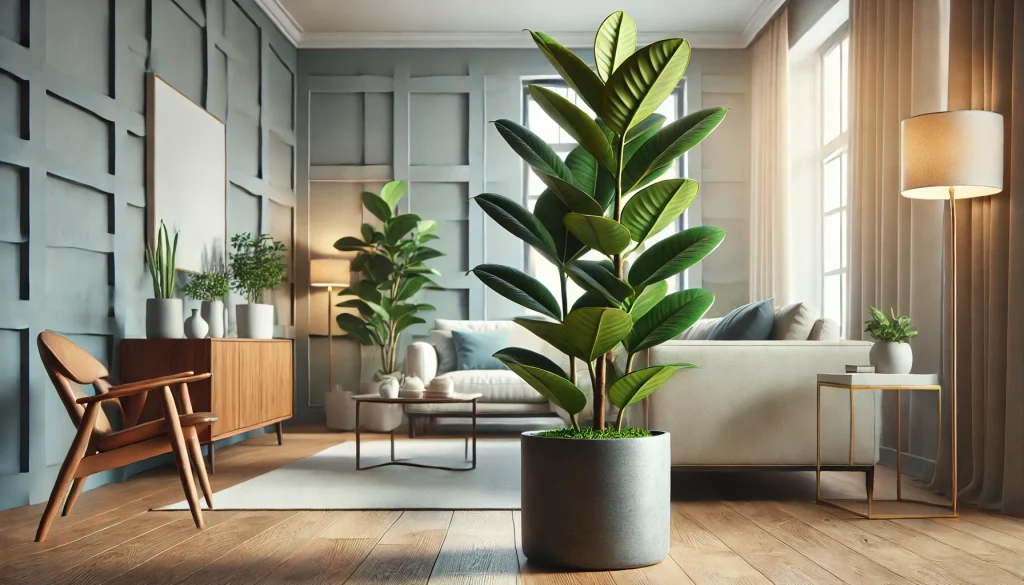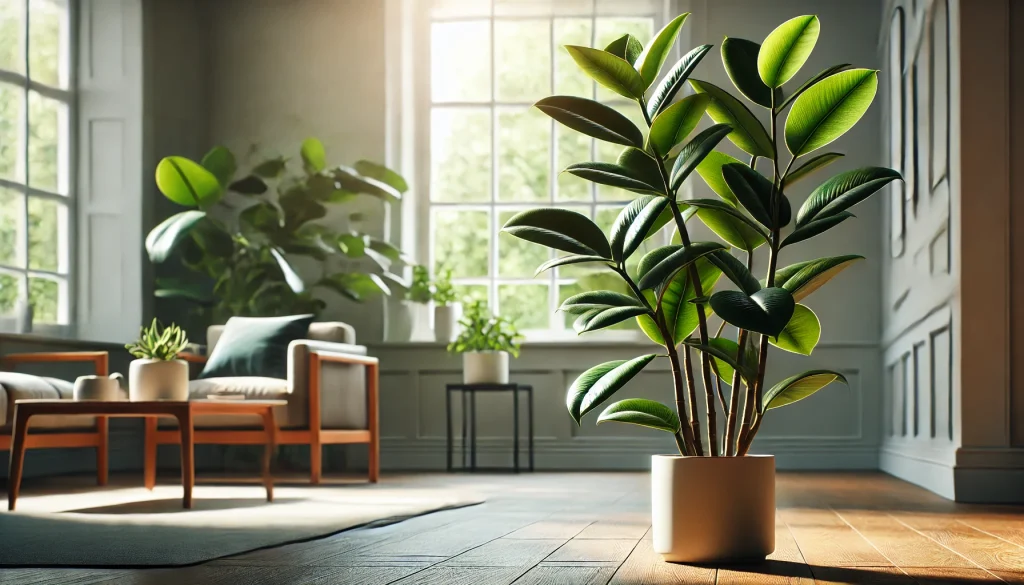This post contains affiliate links. If you buy something from one of our links we may earn a commission. Thanks

Discover Rubber Plant Care Tips for healthy, glossy leaves. Learn watering, sunlight, pruning secrets, and Feng Shui tips to keep your Rubber Plant thriving.
Why Grow Rubber Plants Indoors?
By using our rubber plant care tips you can turn this striking houseplant into the showpiece of your home.
Struggling with droopy leaves or slow growth? Don’t worry—these simple, practical tips will have your Rubber Plant thriving in no time.
Let’s dig into everything you need to keep your plant happy, healthy, and absolutely stunning.

Costa Farms Burgundy Rubber Plant, Live Indoor Ficus Elastica Tree, Live Indoors Houseplant in Décor Planter Pot, Potting Soil Mix, Gift for Housewarming New House, Home or Office Decor, 2-3 Feet Tall
Rubber Plant Care Tips Key Takeaways
- Rubber Plant Care Tips include placing the plant in bright indirect light.
- Water when the top inch of soil is dry, and maintain moderate humidity.
- Use well-draining soil and fertilize monthly during the growing season.
- Prune leggy stems to encourage bushy growth and remove brown leaves to keep your plant looking vibrant.
1. Rubber Plant Care Basics
Rubber Plants are low-maintenance, but giving them the right care ensures they thrive and look their best.
Understanding their basic needs, from lighting to watering and humidity, will set you up for success.
Let’s go over the essentials to keep your Rubber Plant healthy and happy.
Lighting Requirements: Bright and Indirect
Rubber Plants love bright, indirect sunlight, which helps maintain their glossy, vibrant leaves.
- Best Spot: Place near an east- or west-facing window with filtered light.
- What to Avoid: Direct sunlight can scorch their leaves, while low light may stunt growth.
Watering Tips: When to Hydrate
Getting the watering routine right is crucial for Rubber Plants. Too much or too little can cause problems.
- When to Water: Check the top inch of soil—if it’s dry, it’s time to water.
- Drainage Matters: Always use a pot with drainage holes to prevent soggy roots.
Humidity Needs: Keep It Comfortable
Rubber Plants thrive in moderate to high humidity, mimicking their native tropical environment.
- Simple Tricks: Mist the leaves occasionally or place a small humidifier nearby.
- Dry Conditions: Watch for browning edges, a common sign of low humidity.
By meeting these basic care needs, your Rubber Plant will grow lush and vibrant, adding a bold statement to your indoor space.🌿
Rubber Plant Care Reference Guide
| Characteristic | Details |
|---|---|
| Common Name | Rubber Plant |
| Botanical Name | Ficus elastica |
| Native Habitat | Tropical Asia |
| Plant Type | Evergreen tree or shrub |
| Growth Pattern | Upright, compact growth with bold, glossy leaves |
| Mature Size | 6-10 feet indoors, up to 50 feet outdoors |
| Watering | Water when the top inch of soil is dry; avoid overwatering |
| Light/Sun Exposure | Bright, indirect sunlight |
| Soil Type | Well-draining potting soil with organic matter |
| Soil pH | Slightly acidic to neutral (6.0–7.0) |
| Temperature | 65°F to 80°F (18°C to 27°C) |
| Humidity | Moderate to high; occasional misting is beneficial |
| Bloom Time & Flower Color | Rare indoors; small, inconspicuous flowers |
| Potential Problems | Leaf drop, browning edges, overwatering, pests (spider mites, scale) |
| Repotting | Every 2-3 years or when root-bound |
| Hardiness Zones (USDA) | Zones 10–11 (outdoors); thrives as an indoor plant in all zones |
2. Feng Shui Placement for Rubber Plants

In Feng Shui, plants are more than just décor. They’re tools for enhancing the energy flow in your home.
Rubber Plants, with their bold, upward-growing leaves, are especially powerful in promoting prosperity and balance.
Knowing where to place them can make all the difference in creating a harmonious space.
Ideal Locations: Attract Positive Energy
Strategic placement of your Rubber Plant can amplify its Feng Shui benefits.
- Southeast Corner: Known as the wealth corner, this area boosts prosperity and abundance.
- Entryways: Placing a Rubber Plant near the entrance invites fresh energy into your home.
- Living Rooms or Offices: These active spaces benefit from the calming, grounding energy of Rubber Plants.
Avoid These Spots: Blocked Energy Zones
To keep your Rubber Plant thriving and its energy flow effective, avoid these common pitfalls.
- Low-Light Areas: Rubber Plants need light to channel their positive energy; dark corners won’t do.
- Cluttered Spaces: Stagnant or messy areas can hinder the plant’s ability to harmonize with the environment.
- Drafty Locations: Sudden temperature changes from vents or windows can stress the plant.
Placing your Rubber Plant with Feng Shui in mind enhances its beauty and brings a sense of balance and prosperity to your home.🌱
3. Watering Schedule for Rubber Plants
Getting the watering routine right is key to keeping your Rubber Plant healthy. Too much water can lead to root rot, while too little can cause drooping leaves. With a bit of attention, you can strike the perfect balance.
Frequency: How Often to Water
Rubber Plants don’t need constant watering but still like consistent care.
- Weekly Check: Water every 1-2 weeks, depending on how quickly the soil dries.
- Seasonal Adjustments: Increase frequency in warmer months and reduce during fall and winter when growth slows.
Drainage Tips: Preventing Overwatering
Good drainage is essential to avoid soggy soil and unhappy roots.
- Pots with Drainage Holes: Always choose containers that allow excess water to escape.
- Check the Soil: Let the top inch dry out before watering to prevent waterlogging.
By sticking to a solid watering routine, your Rubber Plant will stay vibrant and healthy, with glossy leaves that are a joy to care for.🌿
4. Rubber Plant Fertilizer and Soil Guide
Healthy soil and the right nutrients are the foundation of a thriving Rubber Plant.
Whether you’re repotting or just refreshing the soil, choosing the right mix and feeding schedule will keep your plant strong and vibrant.
Let’s break down the essentials for soil and fertilizer.
Soil Type: Well-Draining and Nutrient-Rich
Rubber Plants prefer soil that retains some moisture but doesn’t get soggy.
- Ideal Mix: Use a well-draining potting soil like coco coir and perlite enriched with organic matter like compost or worm castings.
- Pro Tip: Add extra perlite to potting soil to improve drainage and prevent waterlogging.
Fertilizer Needs: Feed for Growth
During the growing season (spring and summer), Rubber Plants benefit from regular feeding to support their bold, glossy leaves.
- What to Use: A balanced liquid fertilizer (e.g., 10-10-10 or 20-20-20) works well.
- When to Feed: Fertilize once a month during active growth. Skip fertilizing in the fall and winter when the plant’s growth slows.
With the right soil and feeding routine, your Rubber Plant will flourish, giving you those stunning leaves it’s known for.🌿
5. How to Make a Rubber Plant Bushy
A bushy Rubber Plant looks fuller and healthier and adds a striking focal point to your indoor space.
With a little care and some strategic pruning, you can encourage your plant to grow dense, lush foliage. Here’s how to get started.
Pruning Tips: Encourage New Branching
Pruning is the key to making your Rubber Plant bushy by stimulating growth in multiple directions.
- Trim the Tops: Use clean, sharp scissors to cut back leggy stems just above a leaf node. This encourages new branches to form.
- Remove Weak Growth: Snip off any spindly or unhealthy stems to redirect energy to healthier parts of the plant.
Rotate the Plant: Even Out the Growth
Uneven light exposure can cause your Rubber Plant to grow lopsided, with foliage concentrated on one side.
- Weekly Turns: Rotate the plant a quarter turn every week to ensure all sides get equal light.
- Bright, Indirect Light: Place your Rubber Plant in a well-lit spot to encourage balanced growth.
With consistent pruning and rotation, your Rubber Plant will transform into a bushy, vibrant showpiece you’ll be proud to display.🌿
6. Propagating Rubber Plants
Want more Rubber Plants without buying new ones? Propagating them at home is simple and rewarding.
With just a few steps, you can turn a healthy cutting into a thriving new plant.
Step-by-Step Guide to Successful Propagation:
Division is not a viable method for propagating Rubber Plants because they don’t grow from clusters or offsets like some other houseplants.
Rubber Plants have a single main stem or trunk, which means propagation is best achieved through stem cuttings.
Propagation Method: Taking Cuttings
The first step to propagating a Rubber Plant is selecting and preparing the right cutting.
- Choose the Cutting: Look for a healthy stem with at least one leaf node (the small bump where leaves grow).
- Make the Cut: Use clean, sharp scissors to cut a stem section about 6 inches long.
- Prepare the Cutting: Remove the lower leaves to leave the node exposed, which is where roots will grow.
Rooting Tips: Water or Soil?
Once you have your cutting, it’s time to root it. You can choose between water or soil propagation based on your preference.
- Water Propagation:
- Place the cutting in a jar of clean water, ensuring the node is submerged.
- Change the water every 5–7 days to prevent stagnation.
- Roots typically appear within 2–4 weeks.
- Soil Propagation:
- Plant the cutting in moist, well-draining potting soil.
- Cover it with a clear plastic bag to create a greenhouse effect, maintaining high humidity.
- Keep the soil slightly moist, and roots should develop in 4–6 weeks.
- Using a rooting hormone can help speed up the rooting process.
Care for New Plants
Once the roots are about 1–2 inches long (for water propagation) or the cutting starts growing new leaves (for soil propagation), it’s ready to be potted.
- Potting: Use well-draining soil and a small pot with drainage holes.
- Light: Place the new plant in bright, indirect light to encourage growth.
With patience and care, you’ll soon have a healthy new Rubber Plant to add to your collection or share with a friend.🌿
7. Troubleshooting Rubber Plant Problems
Even with the best care, your Rubber Plant might face a few challenges. From leaf drops to pest infestations, knowing how to identify and fix these issues quickly will keep your plant thriving.
Let’s go over some common problems and their solutions.
Leaf Drop: A Warning Sign
When your Rubber Plant starts dropping leaves, it’s usually signaling that something isn’t quite right.
- Overwatering: Too much water can lead to root rot, causing the plant to shed its leaves. Let the soil dry out before watering again.
- Insufficient Light: Rubber Plants need bright, indirect light to stay healthy. Move the plant closer to a bright window if it’s not getting enough light.
Browning Edges: Dry Air or Inconsistent Care
Browning edges on the leaves are often linked to environmental factors.
- Low Humidity: Rubber Plants love humidity. Mist the leaves or use a humidifier to keep the air around the plant moist.
- Inconsistent Watering: Letting the soil dry out too much between waterings can stress the plant. Stick to a steady watering schedule.
Pest Control: Watch for Intruders
Pests like spider mites and scale can harm your Rubber Plant if left untreated.
- Spider Mites: Look for fine webbing on the leaves. Treat by rinsing the plant with water or spraying it with neem oil.
- Scale Insects: These appear as small, brown, oval spots on the stems and leaves. Remove them manually with a cotton swab dipped in rubbing alcohol or use insecticidal soap.
General Care Tips
- Clean the Leaves: Dust can block sunlight and attract pests, so wipe leaves with a damp cloth regularly.
- Check Drainage: Ensure your pot has drainage holes to prevent water-related issues.
With these tips, you’ll be able to tackle most issues your Rubber Plant might face, ensuring it stays lush and healthy.🌿
8. Rubber Plant Indoor Benefits
Rubber Plants aren’t just about aesthetics. They bring a host of benefits to your indoor space.
From purifying the air to creating a stunning visual impact, these plants are more than just a pretty addition to your home.
Let’s explore what makes them such a valuable choice for indoor gardening.
Air Purification: A Natural Cleaner
Rubber Plants are great at improving indoor air quality, making your home a healthier place to live.
- Toxin Removal: They help filter harmful chemicals like formaldehyde, benzene, and carbon monoxide from the air.
- Better Breathing: Cleaner air reduces irritants and promotes a fresher, more breathable environment.
Aesthetic Value: A Bold Statement
With their large, glossy leaves, Rubber Plants are natural attention-grabbers that add elegance and charm to any room.
- Modern Appeal: Their bold, upright growth complements contemporary and minimalist decor.
- Versatile Styling: Whether placed in a corner or used as a centerpiece, they make any space feel more vibrant and polished.
Adding a Rubber Plant to your home enhances the environment and creates a beautiful focal point that’s hard to miss.🌿
9. Rubber Plants and Positive Energy Flow
Rubber Plants aren’t just about looks. They can also enhance the energy flow in your home.
With their strong, upright growth and lush leaves, they symbolize vitality and progress, making them a natural fit for creating harmony and balance in your space.
Here’s how they contribute to positive energy:
Chi Enhancement: Growth and Vitality
In Feng Shui, Rubber Plants are prized for their ability to encourage the upward movement of energy, known as Chi.
- Symbolism: Their vertical growth represents progress, growth, and abundance.
- Where to Place: Position them in areas associated with personal or professional advancement, like your office or living room.
Read more: Understanding Chi and Indoor Plants: Elevate Chi Energy
Harmonizing Spaces: Balancing Energy
Rubber Plants are great at creating a serene and balanced environment, especially in spaces with stagnant or chaotic energy.
- Energy Balance: Their lush, full foliage helps soften sharp angles and brings calming vibes to the room.
- Strategic Placement: Use them in corners or near electronics to balance energy flow and reduce negativity.
By incorporating Rubber Plants into your home with intention, you can create a peaceful, harmonious atmosphere that supports your well-being and goals.🌿
10. Seasonal Care for Rubber Plants
Rubber Plants may be resilient, but their care needs change with the seasons.
Adjusting your routine to match their natural growth cycles helps ensure they stay healthy and vibrant throughout the year.
Here’s how to keep your plant thriving, no matter the time of year.
Spring/Summer: Active Growth Season
During the warmer months, Rubber Plants are in their prime, actively growing and putting out new leaves.
- Watering: Increase the frequency of watering to keep the soil consistently moist but not soggy.
- Fertilizing: Feed the plant with a balanced liquid fertilizer once a month to support growth and leaf production.
- Light: Ensure they get plenty of bright, indirect sunlight to fuel their energy needs.
Fall/Winter: Rest and Recovery
As temperatures drop, Rubber Plants naturally slow their growth, requiring less attention.
- Watering: Allow the soil to dry out more between waterings—every 2-3 weeks is usually sufficient.
- Fertilizing: Stop fertilizing entirely, as the plant doesn’t need extra nutrients during dormancy.
- Humidity: Winter air can get dry, so increase humidity with misting or a humidifier to prevent leaf browning.
With these seasonal adjustments, your Rubber Plant will thrive, looking its best year-round.🌿
Indoor Rubber Plant Care Tips FAQs
Caring for a Rubber Plant can sometimes come with a few questions, especially if you’re new to this stunning houseplant.
Whether it’s about watering, light needs, or placement, we’ve got the answers to help you keep your Rubber Plant thriving and looking its best.
Let’s clear up the most common concerns!
Q. How do you care for a rubber plant indoors?
A. Provide bright, indirect light, water when the topsoil feels dry, and keep the humidity moderate. Use well-draining soil and fertilize monthly in spring and summer.
Q. How frequently should I water my rubber plant?
A. Water your Rubber Plant every 1-2 weeks or when the top inch of soil is dry. Adjust based on temperature and humidity.
Q. Does a rubber plant need sunlight?
A. Yes, it thrives in bright, indirect sunlight. Avoid direct sun, which can scorch its leaves.
Q. Should I cut brown leaves off a rubber plant?
A. Yes, trim off brown or damaged leaves to promote healthy growth and maintain the plant’s appearance.
Q. How do I know if my rubber plant is happy?
A. A happy Rubber Plant has vibrant, glossy leaves, steady growth, and no signs of drooping or discoloration.
Q. Do rubber plants like misting?
A. Yes, they enjoy occasional misting, especially in dry environments. This helps maintain their preferred humidity levels.
Q. Where should you place a rubber plant?
A. Place it near a bright window with indirect sunlight. Avoid drafty spots or areas with low light.
Conclusion: Rubber Plant Care Tips Indoors
Rubber Plants are a perfect combination of beauty, resilience, and functionality, making them a standout choice for indoor gardening.
Their bold, glossy leaves and air-purifying qualities add charm and health benefits to any space.
By understanding their care needs and making small adjustments to their environment, you can ensure your Rubber Plant thrives for years to come.
Recap of Subtopics
Let’s revisit what we’ve covered to help you give your Rubber Plant the care it deserves:
- Rubber Plant Care Basics: Bright, indirect light, moderate watering, and consistent humidity are essential.
- Feng Shui Placement: Position your plant in areas like the Southeast corner to attract positive energy and prosperity.
- Watering Schedule: Water every 1-2 weeks, ensuring the soil is dry at the top before watering again.
- Fertilizer and Soil: Use well-draining soil and feed monthly during the growing season for healthy growth.
- How to Make a Rubber Plant Bushy: Prune leggy stems and rotate the plant for even light exposure.
- Propagating Rubber Plants: Grow new plants from stem cuttings in water or soil with minimal effort.
- Troubleshooting Problems: Address leaf drop, browning edges, and pests quickly to keep your plant healthy.
- Indoor Benefits: Rubber Plants purify air and enhance your home’s aesthetic with their striking appearance.
- Positive Energy Flow: Promote harmony and vitality with the plant’s upright growth and balanced placement.
- Seasonal Care: Adjust watering and fertilization routines based on the plant’s active and dormant seasons.
By following these Rubber Plant Care tips, you’ll enjoy a thriving, vibrant plant that enhances your home’s beauty and energy.
Whether you’re a seasoned indoor gardener or just starting out, these steps make Rubber Plant care straightforward and rewarding. Happy growing! 🌿
Read and learn more:
Growing Feng Shui Plants: Unlock Harmonious Greenery
Hanging Plants and Vertical Gardens in Feng Shui: Easy Guide
Indoor Plants and Feng Shui: Cultivate Positive Energy in Your Space
Feng Shui Plants: 47 Best Feng Shui Plants for Home
Visit my Amazon Influencer Page for videos and gardening products Grow Your Own Garden

 Hey there, plant lovers! I'm Steve, the green thumb behind
Hey there, plant lovers! I'm Steve, the green thumb behind